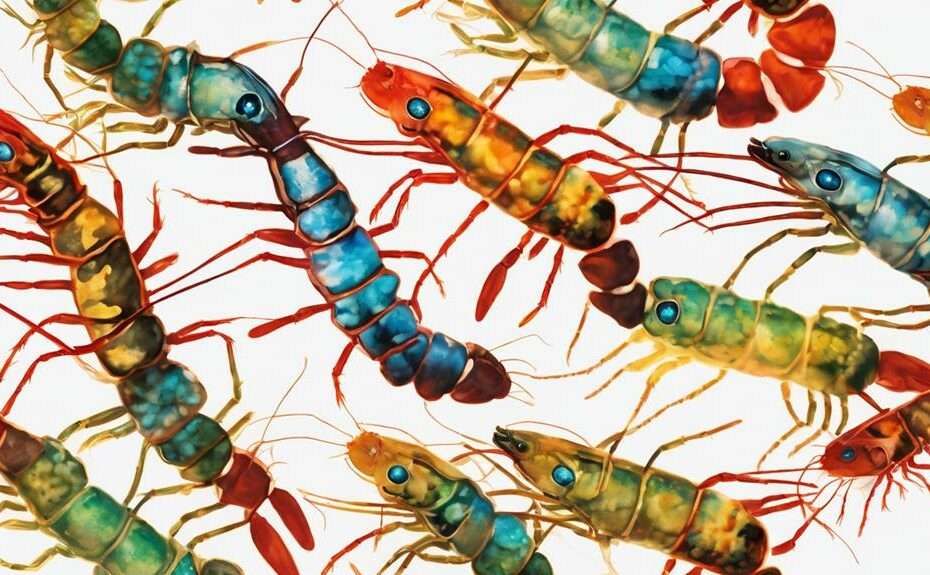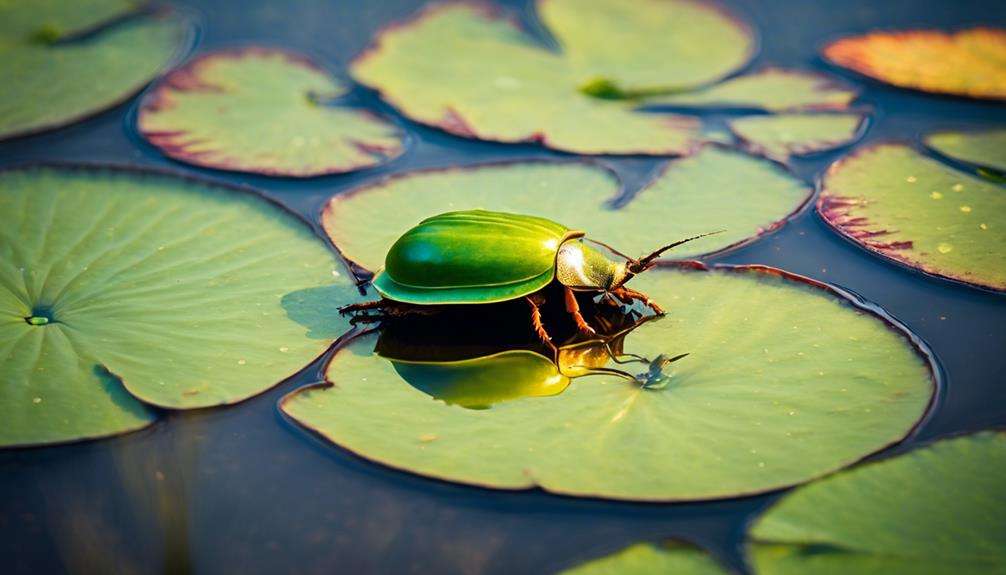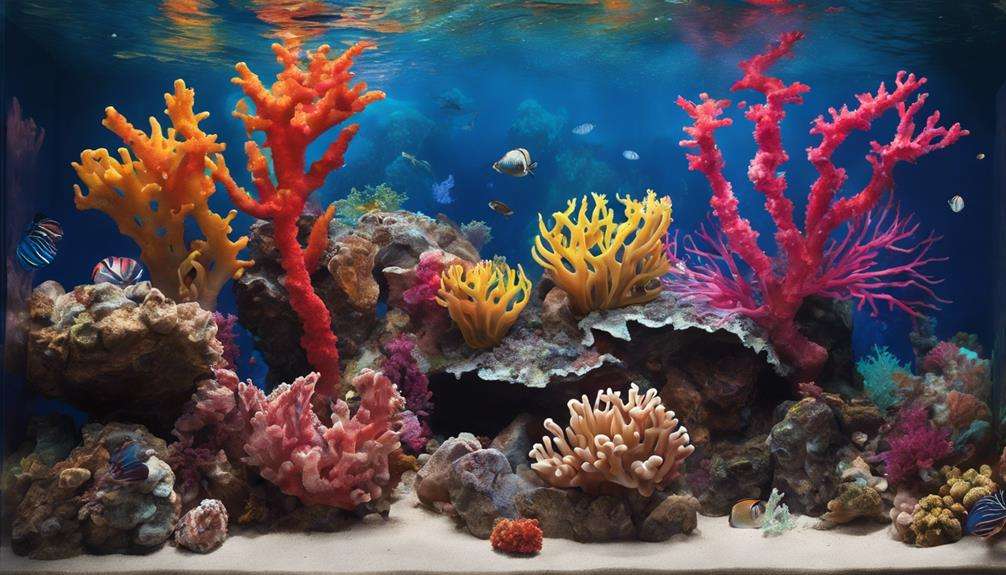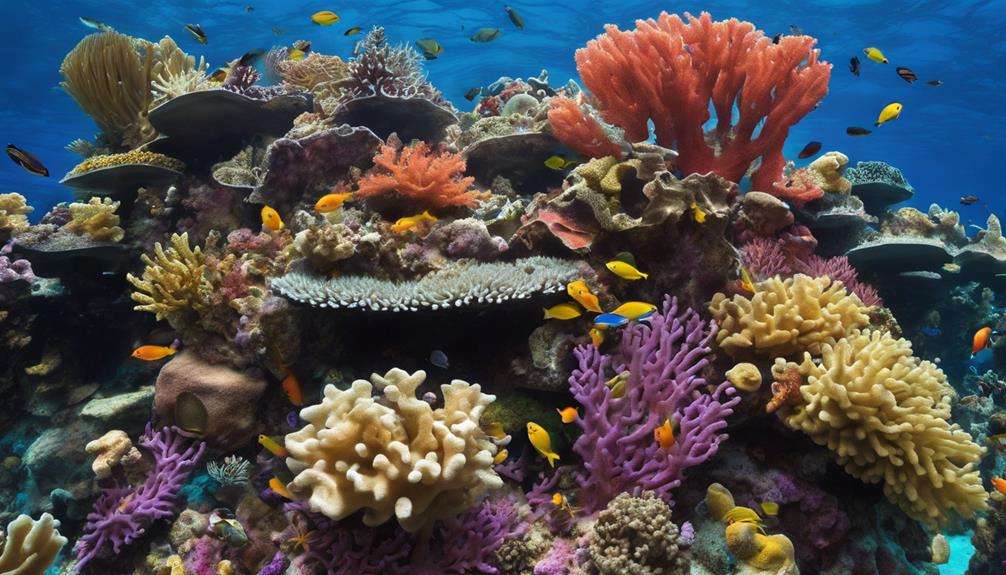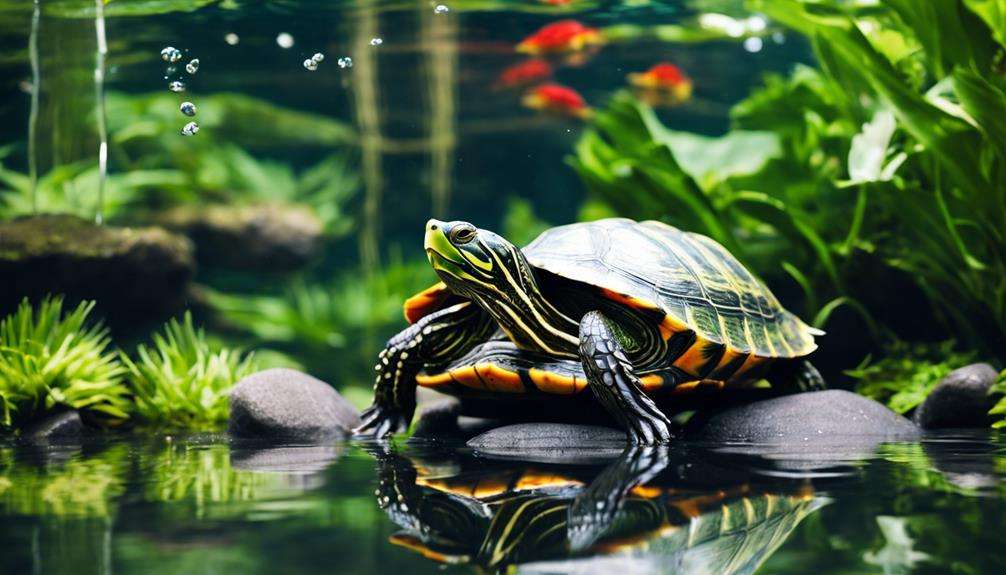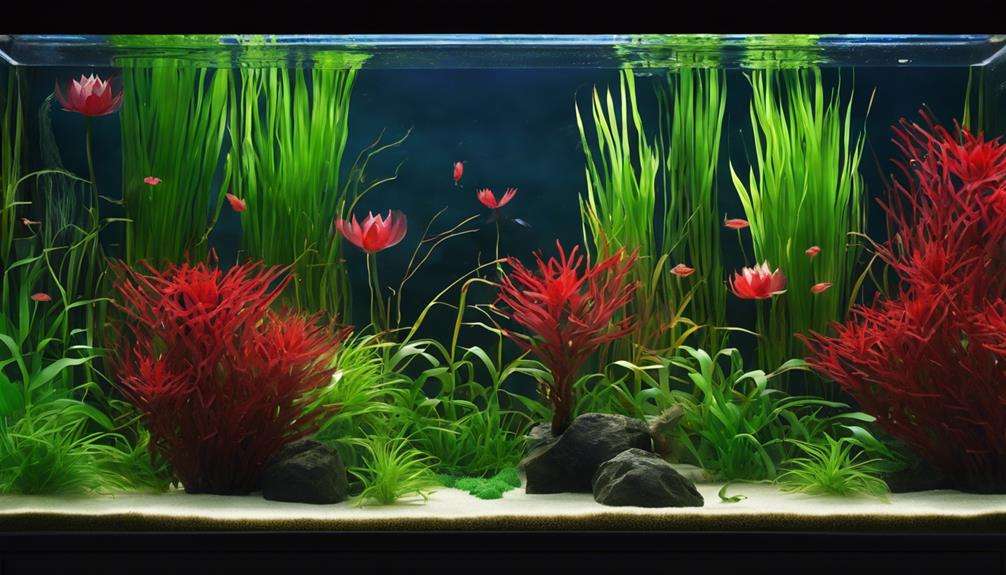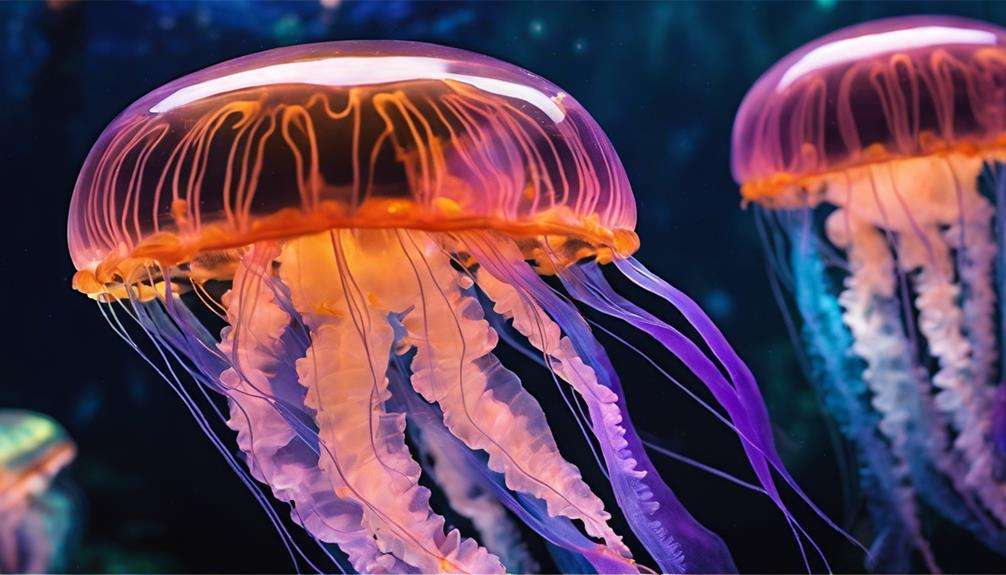Freshwater shrimp varieties are truly enchanting creatures that offer a world of wonder within your aquarium. From their intricate feeding habits to their stunning colors and behaviors, these tiny crustaceans pack a punch in terms of fascination.
But what makes them even more intriguing is their ability to adapt to various tank conditions, interact with tank mates, and even reproduce in unique ways.
As you explore the depths of freshwater shrimp keeping, you'll uncover a universe of surprises waiting to be discovered.
Key Takeaways
- Freshwater shrimp varieties offer a wide range of colors and unique characteristics.
- Shrimp behavior, from cleaning tanks to intricate mating rituals, adds interest to aquariums.
- Specialized care requirements, like high currents for bamboo shrimp, make them intriguing to care for.
- Breeding challenges, such as maintaining genetic purity and achieving desired color variations, showcase the complexity of shrimp keeping.
Unique Features of Freshwater Shrimp
Freshwater shrimp exhibit a diverse array of unique features that distinguish them from other aquatic species in the hobbyist aquarium world. Among the most popular types of freshwater shrimp are the Cherry Shrimp and Dwarf Shrimp, belonging to the Caridina and Neocaridina genera. These shrimp are known for their vibrant colors, with the Red Bee variety standing out for its striking red coloration. In addition to their visual appeal, some freshwater shrimp, like the Bamboo shrimp, are filter feeders, requiring specific dietary needs and high water currents in their habitat.
Moreover, certain species of freshwater shrimp, such as the Long-arm shrimp from the Macrobrachium genus, can exhibit aggressive behavior, especially towards each other. This aggressive nature necessitates careful consideration when setting up tanks to prevent conflicts. On the other hand, the Whisker shrimp, a relative of the ghost shrimp, can grow to larger sizes and also demonstrate unique aggressive tendencies, making them intriguing additions to aquariums. These features collectively contribute to the fascination and appeal of freshwater shrimp in the aquarium hobbyist world.
Diversity in Shrimp Colors
Featuring a wide array of vibrant hues, freshwater shrimp varieties showcase a mesmerizing diversity in their coloration. Cherry shrimp, such as Neocaridina davidi, offer a plethora of over 15 color patterns, making them a sought-after choice among enthusiasts.
Bee shrimp, like Caridina cantonensis, exhibit various color morphs including shadow panda, king kong, and blue bolt, adding to the allure of shrimp colors. Cardinal shrimp, known as Caridina dennerli, stand out with their striking red hue adorned with white dots, further enriching the tapestry of colors in freshwater shrimp species.
The red, blue, and other vivid colorations present in shrimp like blue bolt, tangerine tiger, and panda contribute to the visual appeal of aquarium setups, captivating hobbyists with their stunning hues. The diverse range of colors and patterns among freshwater shrimp not only beautifies aquatic environments but also showcases the fascinating natural variations within these alluring crustaceans.
Fascinating Shrimp Behavior
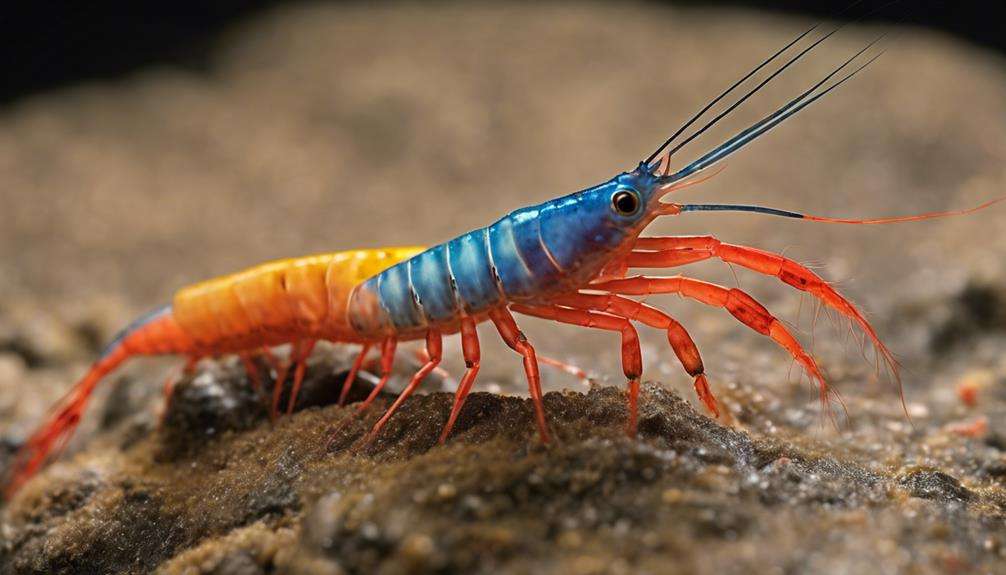
Within the intricate world of freshwater shrimp varieties, their enchanting behaviors offer a glimpse into the dynamic interactions and social dynamics within aquarium ecosystems. Freshwater shrimp exhibit fascinating cleaning behaviors, actively consuming algae, debris, and waste, contributing to the overall cleanliness of the tank. Some shrimp species showcase elaborate mating rituals and courtship behaviors, adding a layer of complexity and interest to their interactions. Socially, shrimp engage in hierarchical structures and communication through intricate body language and movements, highlighting their evolved social behaviors.
Moreover, certain shrimp species, like the Amano shrimp, demonstrate unique foraging behaviors by actively seeking out and consuming algae in planted tanks, playing a vital role in maintaining the tank's ecological balance. It's important to note that shrimp behavior is influenced by various environmental factors such as water parameters, tank mates, and food sources, making their behavior not only intriguing but also responsive to their surroundings. Observing and studying these behaviors can provide valuable insights into the inner workings of these fascinating creatures.
Specialized Shrimp Care Requirements
Specialized care requirements for various freshwater shrimp species necessitate specific attention to their unique dietary and environmental needs to guarantee their well-being in aquarium settings. Bamboo shrimp, as filter feeders, require high current in shrimp tanks to simulate their natural habitat and meet their specialized dietary needs adequately.
Long-arm shrimp, known to grow up to 4 to 6 inches, exhibit important behavior, making it essential to house them separately to avoid conflicts. Similarly, whisker shrimp, larger counterparts to ghost shrimp, can also display aggressive tendencies, requiring careful consideration when choosing tank mates. Long-arm shrimp shouldn't be housed with fish they can prey on due to their aggressive nature.
Advanced aquarists are best suited for bamboo shrimp care due to their specific requirements for thriving in an aquarium environment, ensuring a suitable habitat that meets their needs for the best health and well-being.
Exotic Shrimp Breeding Challenges
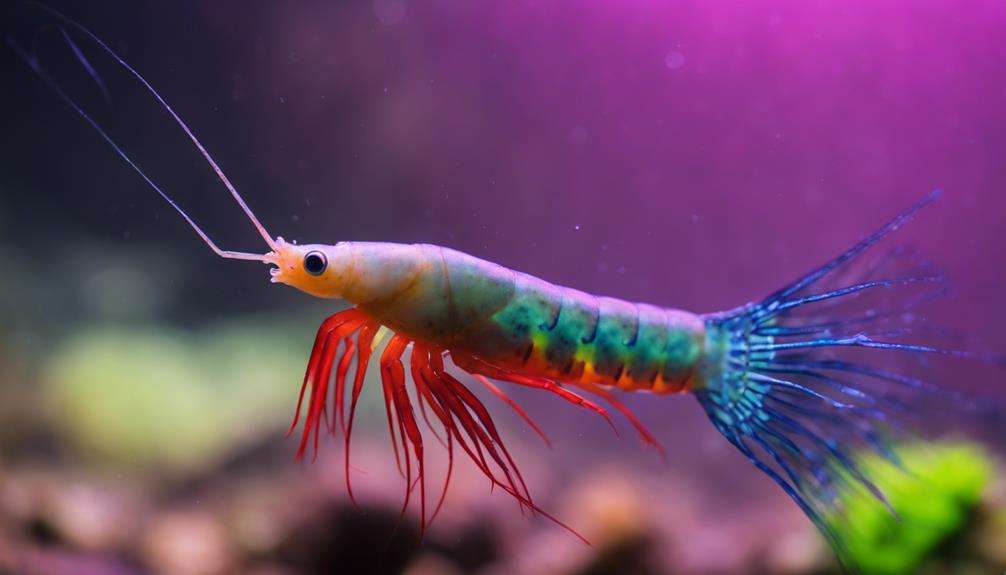
Breeding exotic freshwater shrimp varieties poses significant challenges due to the specific water parameter requirements essential for successful reproduction. Maintaining genetic purity and color strains is vital in exotic shrimp breeding to preserve desired traits.
Achieving desired color variations often involves complex genetics and selective breeding techniques. Species like the Taiwan Bee Shrimp require precise water conditions and specialized care for successful breeding. These challenges in exotic shrimp breeding necessitate meticulous attention to water quality, diet, and tank setup to support reproduction.
Ensuring the right balance of water parameters, such as pH, temperature, and mineral content, is essential for the health and reproduction of exotic shrimp species. Breeders must also carefully monitor genetic lines to prevent undesirable traits from emerging. Meeting these demanding requirements is fundamental to successfully breeding exotic freshwater shrimp varieties with the desired characteristics and color variations.
Frequently Asked Questions
Why Are Freshwater Shrimp Important?
Freshwater shrimp are important for maintaining ecosystem balance. They contribute to aquatic biodiversity, water quality, nutrient cycling, and the aquatic food chain. Their role in habitat restoration, species interactions, and serving as environmental indicators is vital for aquatic conservation efforts.
What Are Freshwater Shrimp Especially Good At?
Freshwater shrimp are exceptional aquatic scavengers, efficient cleaners, and nutrient recyclers. They excel at consuming algae, debris, and waste, contributing to the ecosystem's balance. Shrimps are important bioindicators of pollution and play an essential role in maintaining aquatic biodiversity.
What Are the Characteristics of Freshwater Shrimp?
Freshwater shrimp showcase a spectrum of hues and exhibit distinct behaviors. They aid in tank maintenance as efficient aquatic scavengers, benefiting freshwater ecosystems. Hardy bottom feeders, they molt to grow, contributing to biological control. Ornamental species, they captivate with their beauty and utility.
What Do Freshwater Shrimp Taste Like?
Freshwater shrimp have a mild, sweet flavor reminiscent of lobster or crab. Their delicate, slightly briny taste complements various dishes. When cooked, they offer a firm, slightly crunchy texture, absorbing flavors well for versatile culinary creations worldwide.
Conclusion
You may think that freshwater shrimp are just small crustaceans, but their intricate colors, behaviors, and care requirements prove otherwise.
The challenge of breeding these exotic creatures adds an extra layer of fascination for hobbyists.
So next time you see a Cherry Shrimp darting around its tank or a Taiwan Bee Shrimp displaying its vibrant colors, remember that these tiny creatures are far more enthralling and complex than meets the eye.
